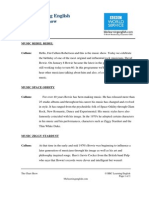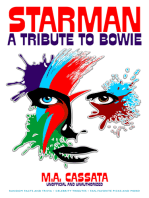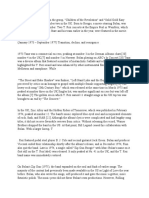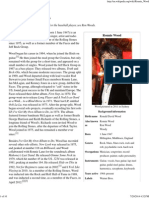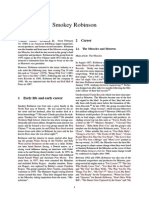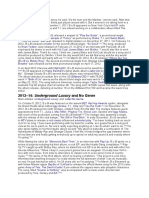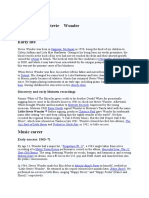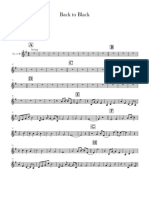David Bowie
David Bowie
Uploaded by
Erin GriffithCopyright:
Available Formats
David Bowie
David Bowie
Uploaded by
Erin GriffithCopyright
Available Formats
Share this document
Did you find this document useful?
Is this content inappropriate?
Copyright:
Available Formats
David Bowie
David Bowie
Uploaded by
Erin GriffithCopyright:
Available Formats
Angus Fretwell
David Bowie
David Bowie is an English singer and multi-instrumentalist known for reinventing himself
and his music, he widely considered an ‘innovator’ for his work in the 1970s. Over the
course of the last five decades, Bowie has released 25 albums, plus many more singles,
extended plays, compilations, soundtracks, and live albums. He has been recognized by the
BBC as one of the ‘100 Greatest Britons’, and ranked at #39 on the Rolling Stone magazine’s
‘100 Greatest Rock Artists’.
David Bowie’s first release was his self-titled album released in 1967 - however, none of the
material from this album managed to reach charts. He first gained recognition when he
released ‘Space Oddity’ in 1969 to coincide with the moon landing; the song tells the story of
Major Tom, an astronaut who is lost in space. It was featured during the Apollo 11 coverage
by the BBC.
The next year Bowie released another album, ‘The Man Who Sold the World,' which
replaced the acoustic style of the ‘Space Oddity’ album with a heavy rock backing by
guitarist Mick Ronson. The cover of the album pictured Bowie wearing a dress - one of the
first examples of his ‘androgynous’ appearance.
‘Hunky Dory’ was released in 1971, with a return of an acoustic style, similar to that of
Space Oddity. The album and it’s accompanying single ‘Changes’ were not major hits, but
started Bowie’s rise to fame that would see him four top-ten albums and eight top-ten
singles over the following two years.
In 1972, David released his concept album ‘The Rise and Fall of Ziggy Stardust and the
Spiders from Mars’ the album combined the styles of the previous two albums, as well as
the glam-rock style introduced by bands such as Marc Bolan’s ‘T. Rex.' The album contained
many of Bowie’s best known songs, such as ‘Ziggy Stardust,' ‘Moonage Daydream, and
‘Suffragette City.'
The ‘Ziggy Stardust’ character and Bowie’s rising popularity lead to a large scale tour, where
Bowie further explored his androgynous appearance with his red mullet and eccentric
outfits. Later that year, Bowie worked with his influence and rock-and-roll idol Lou Reed (of
Velvet Underground). He produced Reed’s second breakthrough solo album ‘Transformer,'
which he also recorded backing vocals for.
In 1973, Bowie released his first number-one album ‘Aladdin Sane’ that featured the
number-two hit ‘The Jean Genie’ and the number-three hit ‘Drive-In Saturday.' The album
cover featured Bowie’s famous ‘lightening bolt’ make-up. Upon the release of Aladdin Sane,
Bowie toured again, performing more ‘Ziggy’ shows, featuring songs from both the ‘Aladdin
Sane’ and ‘Ziggy Stardust’ albums.
After Bowie’s early ‘Glam Rock’ albums he released a number of later albums of different
genres, including Soul and R&B albums such as ‘Young Americans’ and ‘Station to Station,'
his ‘Berlin’ albums, a collaboration with Brian Eno, and 80s albums such as ‘Scary Monsters
(and Super Creeps)’ and ‘Let’s Dance.' In recent years, Bowie has collaborated and
performed with newer artists; performing with artists such as Placebo, Arcade Fire, and
Trent Reznor (of Nine Inch Nails), who produced the single from his album ‘Earthling,’
entitled ‘I’m Afraid of Americans’.
You might also like
- Guided Listening AssignmentDocument5 pagesGuided Listening AssignmentCharmsJr94No ratings yet
- Beck HansenDocument96 pagesBeck HansenDavid0% (1)
- Sly and The Family StoneDocument9 pagesSly and The Family StonebillNo ratings yet
- Rebel Rebel: All the Songs of David Bowie From '64 to '76From EverandRebel Rebel: All the Songs of David Bowie From '64 to '76Rating: 5 out of 5 stars5/5 (4)
- The History of Rock #08 - 1972Document148 pagesThe History of Rock #08 - 1972pennyman100% (4)
- If You Like the Beatles...: Here Are Over 200 Bands, Films, Records and Other Oddities That You Will LoveFrom EverandIf You Like the Beatles...: Here Are Over 200 Bands, Films, Records and Other Oddities That You Will LoveNo ratings yet
- BluestemLowMandoPlanFree PDFDocument1 pageBluestemLowMandoPlanFree PDFRoberthe NichanNo ratings yet
- James Bond Theme PDFDocument2 pagesJames Bond Theme PDFbiuttpNo ratings yet
- New Orleans Jazz StylesDocument17 pagesNew Orleans Jazz StylesJose María Varas67% (6)
- Kontakt 5 Factory Scripts EnglishDocument54 pagesKontakt 5 Factory Scripts EnglishPorinsaNo ratings yet
- Asdgasdfgasdgasdgasdg David Robert Jones (Born 8 January 1947), Known by His StageDocument1 pageAsdgasdfgasdgasdgasdg David Robert Jones (Born 8 January 1947), Known by His StageCarlo Maria TollerNo ratings yet
- Who Was David Bowie?Document10 pagesWho Was David Bowie?David BriceñoNo ratings yet
- Media - David Bowie 2Document11 pagesMedia - David Bowie 2meganvellisNo ratings yet
- David Robert Jones (8 January 1947 - 10 January 2016), Known As David Bowie (Document2 pagesDavid Robert Jones (8 January 1947 - 10 January 2016), Known As David Bowie (El ToreroNo ratings yet
- Bowie FinalDocument6 pagesBowie FinalVanessa OrihuelaNo ratings yet
- GoetheDocument2 pagesGoetheistennokmegidiotakNo ratings yet
- Fame (David Bowie Song)Document4 pagesFame (David Bowie Song)Steven WrightNo ratings yet
- David Bowie: BBC Learning English The Music ShowDocument3 pagesDavid Bowie: BBC Learning English The Music ShowMohamad HafizNo ratings yet
- Stardust and The Spiders From Mars, Which Won Him Widespread Popularity. in 1975, Bowie'sDocument2 pagesStardust and The Spiders From Mars, Which Won Him Widespread Popularity. in 1975, Bowie'sMuthia DitaNo ratings yet
- Bowie In Berlin: A new career in a new townFrom EverandBowie In Berlin: A new career in a new townRating: 4 out of 5 stars4/5 (19)
- Bowie on Bowie: Interviews and Encounters with David BowieFrom EverandBowie on Bowie: Interviews and Encounters with David BowieRating: 5 out of 5 stars5/5 (2)
- David Robert JonesDocument1 pageDavid Robert JonesMuthia DitaNo ratings yet
- 25 Amazing Facts Everyone Should Know About David BowieDocument27 pages25 Amazing Facts Everyone Should Know About David BowiesaraNo ratings yet
- David Bowie PDFDocument2 pagesDavid Bowie PDFCeleste SandNo ratings yet
- The Jam PDFDocument11 pagesThe Jam PDFQuirinoNo ratings yet
- History of RockDocument14 pagesHistory of RockGabriela CheaptanaruNo ratings yet
- Rainbow (Rock Band)Document6 pagesRainbow (Rock Band)donNo ratings yet
- David Browie PDFDocument4 pagesDavid Browie PDFDanielNo ratings yet
- History of Music: Jess LoaderDocument9 pagesHistory of Music: Jess LoaderFadlan RezaNo ratings yet
- George BensonDocument4 pagesGeorge BensonburkeNo ratings yet
- History of RockDocument14 pagesHistory of RockorangelzapataNo ratings yet
- Two Stand-Alone Singles From The GroupDocument2 pagesTwo Stand-Alone Singles From The Groupdosonex274No ratings yet
- Ronnie Wood - Wikipedia, The Free EncyclopediaDocument10 pagesRonnie Wood - Wikipedia, The Free EncyclopediabmxengineeringNo ratings yet
- The BeatlesDocument7 pagesThe BeatlesОльга БігайлоNo ratings yet
- David Bowie - Low: Review and Analysis (Part 1)Document6 pagesDavid Bowie - Low: Review and Analysis (Part 1)Joe P67% (3)
- 008-10: Mainstream Success and Debut Album: Main ArticleDocument3 pages008-10: Mainstream Success and Debut Album: Main Articleსო ფიაNo ratings yet
- Biography of Pink FloydDocument2 pagesBiography of Pink FloydRuschottaNo ratings yet
- Rock MusicDocument4 pagesRock Musicrossipe2007No ratings yet
- Iggy PopDocument15 pagesIggy PopAjey BhangaleNo ratings yet
- Iggy Pop Biography FinalDocument2 pagesIggy Pop Biography FinalGastónBütikoferNo ratings yet
- Smokey RobinsonDocument5 pagesSmokey RobinsondonNo ratings yet
- Jimmy Page Boleskine House and The Occul-1Document4 pagesJimmy Page Boleskine House and The Occul-1Carlos JiménezNo ratings yet
- British PopDocument4 pagesBritish Popcem kayaNo ratings yet
- David Bowi1Document2 pagesDavid Bowi1Muthia DitaNo ratings yet
- David BowieDocument21 pagesDavid BowiemajkakurazNo ratings yet
- George Benson.Document7 pagesGeorge Benson.Manzini MbongeniNo ratings yet
- Top 40 Blues Rock AlbumsDocument25 pagesTop 40 Blues Rock AlbumspaoloNo ratings yet
- History of Rock and RollDocument3 pagesHistory of Rock and RollScribdTranslationsNo ratings yet
- 2012-14: Underground Luxury and No Genre: Man & The MartianDocument2 pages2012-14: Underground Luxury and No Genre: Man & The Martianსო ფიაNo ratings yet
- David BowieDocument6 pagesDavid Bowieapi-318489403No ratings yet
- Postmodern Musical ArtistsDocument8 pagesPostmodern Musical Artistslaura_eaton100% (1)
- The Complete David Bowie (Revised and Updated 2016 Edition)From EverandThe Complete David Bowie (Revised and Updated 2016 Edition)Rating: 4.5 out of 5 stars4.5/5 (27)
- QUEEN CompletoDocument16 pagesQUEEN CompletoYessica ChavezNo ratings yet
- Te Elem Dys U9 p107Document2 pagesTe Elem Dys U9 p107Orientación Juan ReyNo ratings yet
- Michael BoltonDocument4 pagesMichael BoltonMelisa MalikNo ratings yet
- Stevie Wonder's LifeDocument19 pagesStevie Wonder's LifeLorelay BoscaNo ratings yet
- Partitura El Vuelo Del Abejorro para Saxo AltoDocument4 pagesPartitura El Vuelo Del Abejorro para Saxo AltoEd ElvesaxNo ratings yet
- ReverbCheatsheet PDFDocument2 pagesReverbCheatsheet PDFKahlil SmithNo ratings yet
- Music of Indian 3rd QuarterDocument17 pagesMusic of Indian 3rd QuarterRoseAuraOdosisHerialesNo ratings yet
- Clarinetin Eastern EuropeDocument16 pagesClarinetin Eastern EuropeKiril BozhidarovNo ratings yet
- Trompet Back To BlackDocument2 pagesTrompet Back To BlackBenny Van AckerNo ratings yet
- Lesson 20 - Practice Christmas SongsDocument5 pagesLesson 20 - Practice Christmas Songs19raner90No ratings yet
- Digital Booklet PDFDocument9 pagesDigital Booklet PDFSamuel Tellez VelazquezNo ratings yet
- Sugar - Jazz Standards Progressions Book AnalyzedDocument1 pageSugar - Jazz Standards Progressions Book AnalyzedBalthazzarNo ratings yet
- Analytical Reasoning - Short Notes - Part 1 of 5Document7 pagesAnalytical Reasoning - Short Notes - Part 1 of 5Muhammad Zubair ShahzadaNo ratings yet
- Symphony X - The Damnation GameDocument6 pagesSymphony X - The Damnation GameSNo ratings yet
- Engines of Creation - Joe SatrianiDocument8 pagesEngines of Creation - Joe SatrianiJP Pretorius100% (1)
- Singorama AdvancedDocument51 pagesSingorama AdvancedLynda ElizabethNo ratings yet
- Compare and Contrast The Texture and Melody of The Miles Davis, Poulenc and BrahmsDocument3 pagesCompare and Contrast The Texture and Melody of The Miles Davis, Poulenc and BrahmsWinston 葉永隆 DiepNo ratings yet
- ESO Signature 8Document40 pagesESO Signature 8Venture PublishingNo ratings yet
- Benny GoodmanDocument48 pagesBenny GoodmanAle c67% (3)
- Say HelloTo CalypsoDocument1 pageSay HelloTo Calypsoeric lohrerNo ratings yet
- Star Wars (Suite For Orchestra) - Deluxe Score by John Williams - Full Score (Spiral Bound) Sheet Music For Full Orchestra (BuyDocument1 pageStar Wars (Suite For Orchestra) - Deluxe Score by John Williams - Full Score (Spiral Bound) Sheet Music For Full Orchestra (BuyCaptain Phoinex0% (2)
- Tremolo Tips For The Classical GuitarDocument5 pagesTremolo Tips For The Classical Guitarniticdan75% (4)
- Increase Endurance For TrumpetDocument4 pagesIncrease Endurance For TrumpetRichy Segarra100% (1)
- Notomania Ru-Adios Nonino PDFDocument10 pagesNotomania Ru-Adios Nonino PDFArusyak HekimyanNo ratings yet
- Music Q2 Week 1Document9 pagesMusic Q2 Week 1edelweissvienna.luzorataNo ratings yet
- My Evening Prayer - TTBBDocument5 pagesMy Evening Prayer - TTBB2ndviolinNo ratings yet
- Fever 01 PianoDocument4 pagesFever 01 PianoАлександр КовалевNo ratings yet
- Elements of Dance: - in Dance, The Body Is The Mobile Figure or Shape, Felt by The Dancer, Seen by Others. TheDocument3 pagesElements of Dance: - in Dance, The Body Is The Mobile Figure or Shape, Felt by The Dancer, Seen by Others. TheMariacherry MartinNo ratings yet
- Timberkits Guitar Instructions 4 2014Document16 pagesTimberkits Guitar Instructions 4 2014JuanCarlosLopezNo ratings yet


















